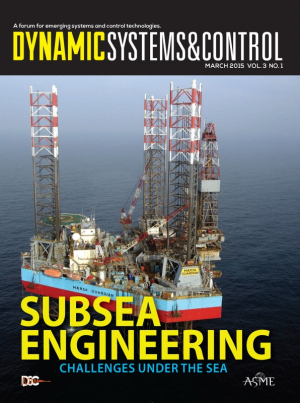The UH Cullen College of Engineering is the world’s clear leader in establishing and standardizing subsea engineering education, research and policymaking. Faculty members in the subsea engineering program at UH are often sought out as experts by media outlets, industry professionals and government officials who are interested in the emerging field of subsea engineering.
Dynamic Systems & Control magazine, a publication of the American Society of Mechanical Engineers (ASME), recently tapped into the subsea engineering talent at the Cullen College for their March 2015 special issue. Three of the four feature articles in the magazine were written by UH subsea engineering professors.
The authors include Matthew Franchek, director of the subsea engineering program at the Cullen College, Phaneendra Kondapi, KBR adjunct professor of subsea engineering, and Egidio Marotta, ABS adjunct professor of subsea engineering.
Franchek’s article, “Project Atlantis: Subsea Oil and Gas Production Cities,” introduces the technologies used in subsea engineering as well as the challenges that arise in the high pressures and low temperatures that exist at depths beyond 10,000 feet.
Kondapi’s feature, “Flow Assurance: Déjà Vu in Subsea Engineering?,” provides engineering solutions for flow assurance, guaranteeing that oil will flow even with wax build-up, solid deposition and corrosion. Kondapi is a senior technical advisor of flow assurance at Granherne-KBR. The subsea engineering flow assurance course he teaches at the Cullen College is one of the most popular graduate courses at the University of Houston, boasting around 140 students this semester.
Marotta is a relative newcomer to the Cullen College’s subsea engineering program. He serves as the manager of the multiphase simulation group and the advanced technology organization of the subsea division at GE Oil & Gas. Marotta’s article, titled “Analysis Led Design in Subsea Engineering: Challenges for Modeling and Simulations of Components and Systems,” described a new analysis led design profess that uses predictive tools to aid in the design of undersea components to ensure reliable performance under adverse conditions.
Together, these three feature articles represent the most current updates and challenges from the subsea engineering field.
The Cullen College started the country’s first academic program the discipline in 2011 and in 2012 began offering the nation’s first master’s degree in subsea engineering, which focuses on the equipment and infrastructure used in the underwater portion of offshore petroleum exploration and retrieval.
In May 2013, the Cullen College took the lead in establishing the first Global Subsea University Alliance, a group consisting of the leaders of the world’s top subsea engineering programs that is dedicated to establishing worldwide standards for subsea engineering education.
In 2013, the Cullen College became a key player in ensuring the safety of offshore energy production for years to come through the establishment of the Ocean Energy Safety Institute (OESI). The institute is a partnership of UH, Texas A&M University and the University of Texas at Austin. The three schools won a competitive five-year, $5 million grant from the Department of the Interior’s Bureau of Safety and Environmental Enforcement to establish the institute to serve as a platform for communications and research among government, academia and industry in the field of offshore energy.
Most recently, the University of Houston was chosen to lead a national research center for subsea engineering and other offshore energy development issues. The Subsea Systems Institute, announced by the Texas Commission on Environmental Quality, will be led by UH, working in collaboration with Rice University, the Johnson Space Center, Texas Southern University, Houston Community College and Lone Star College. It will serve as a liaison for industry and government regulators, testing and validating equipment, helping standard-setting institutions with neutral third-party knowledge and other best practices, developing new materials and science-based policies, as well as overseeing workforce training.
